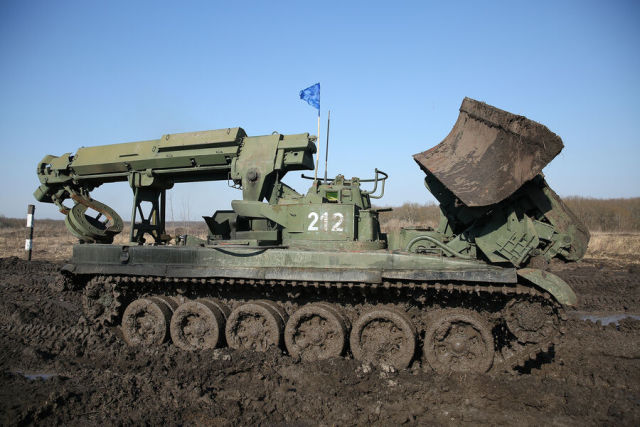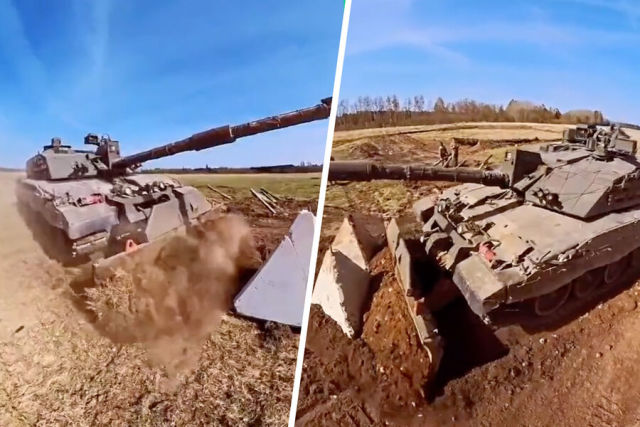Otherwise, they are easily overcome by the advancing enemy In the armored units of the Armed Forces of Ukraine, the Challenger-2 tank produced by the United Kingdom was equipped with devices to overcome the so-called "dragon's teeth".
The military observer of the newspaper dealt with some details of the breakthrough of defensive lines during offensive operations.En" Mikhail Khodarenok.
Devices for overcoming the "dragon's teeth" installed on the British Challenger-2 tank have already been tested by Ukrainian tankers at the training ground. I must say right away that the expediency of such steps on the part of the AFU specialists is far from obvious and even very controversial.
To begin with, let's figure out what the "dragon's teeth" are. From the point of view of the terminology of the engineering troops, it is more correct to call these "teeth" gouges, and they belong to the so-called non-explosive barriers (NVZ).
In addition to the "dragon's teeth", the list of NWZ also includes ditches, escarpments, hedgehogs, barriers, forest blockages, wire barriers (including electrified ones), water, combined barriers in combination with mechanical destruction of bridges, dam gates, culverts on roads.
By the way, in the Belgorod region, the construction of the so-called "zasechnaya line" continued for a very long period, the main part of which was the "dragon's teeth". The work cost the budget 10 billion rubles. Apparently, the authors of the plan for the construction of the "zasechnaya line" were not aware of the full list of NVZ, otherwise the Belgorod "line" (at least in words) would have looked much more spectacular.
In addition to non-explosive barriers, there are also mine-explosive barriers (MVZ), arranged using mines for various purposes and explosive charges (explosives). MVZ, in turn, are divided into anti-tank, anti-personnel, anti-vehicle, anti-airborne and special.
Finally, the combination of MVZ and NVZ constitutes a system of engineering barriers (PPE), which is a combination of barriers and destructions arranged in combination with natural obstacles and in close connection with systems of defensive lines, fire damage and planned maneuver of troops.
This is how the theory looks like. The question arises - why did the enemy formations overcome the "dragon's teeth" so easily during the recent events in the Belgorod region? The fact is that the system of engineering barriers should be most carefully coordinated with the system of complex fire destruction of the enemy (COPP). The latter includes (among other things) a system of fire of tank, anti-tank and small arms in front of the leading edge and in depth.
If there is no such system, and the "dragon's teeth" are in an open field, that is, they are not covered by troops and fire, then overcoming any engineering barriers for the advancing troops does not present any difficulties, which happened in practice in the Belgorod region.
If everything is organized in accordance with all the norms and rules of the art of war, then passages in engineering barriers are made in an explosive way with the use of mine-clearing installations, mine-clearing charges and barrier detachments. The composition of the detachments of the barrier includes, as a rule, mine clearance installations, engineering vehicles of the barrier (IMR) and bridge-laying machines.
You can, of course, hang some engineering equipment on British Challenger-2 tanks, but there are only a company of combat vehicles of this type in the AFU. This is, without exaggeration, a valuable resource, which is hardly advisable to use as engineering barrier vehicles during offensive operations.

Image source: Vitaly Timkiv/RIA Novosti
To solve such problems in the engineering troops there is an IMR. This is, without much exaggeration, a universal fighter of engineering troops. There are such machines as part of the APU. IMRs belong to a group of machines designed for making passages, clearing rubble and destruction. To perform these tasks, IMRs are equipped with bulldozer, crane and additional (bucket, scraper, drill) equipment.
In conclusion, we note that over the past few months, the Armed Forces of the Russian Federation have carried out a significant amount of work on the fortification equipment of defense lanes in the Kherson and Zaporozhye directions. Satellite images of the system of trenches and communication passages, cut-off lines and positions, nodes and barrier zones periodically became the property of the media. It remains to be hoped that in this case the defensive lines are occupied by troops, and the system of explosive and non-explosive barriers is tightly covered by tank, anti-tank and small arms fire.
Mikhail Khodarenok

